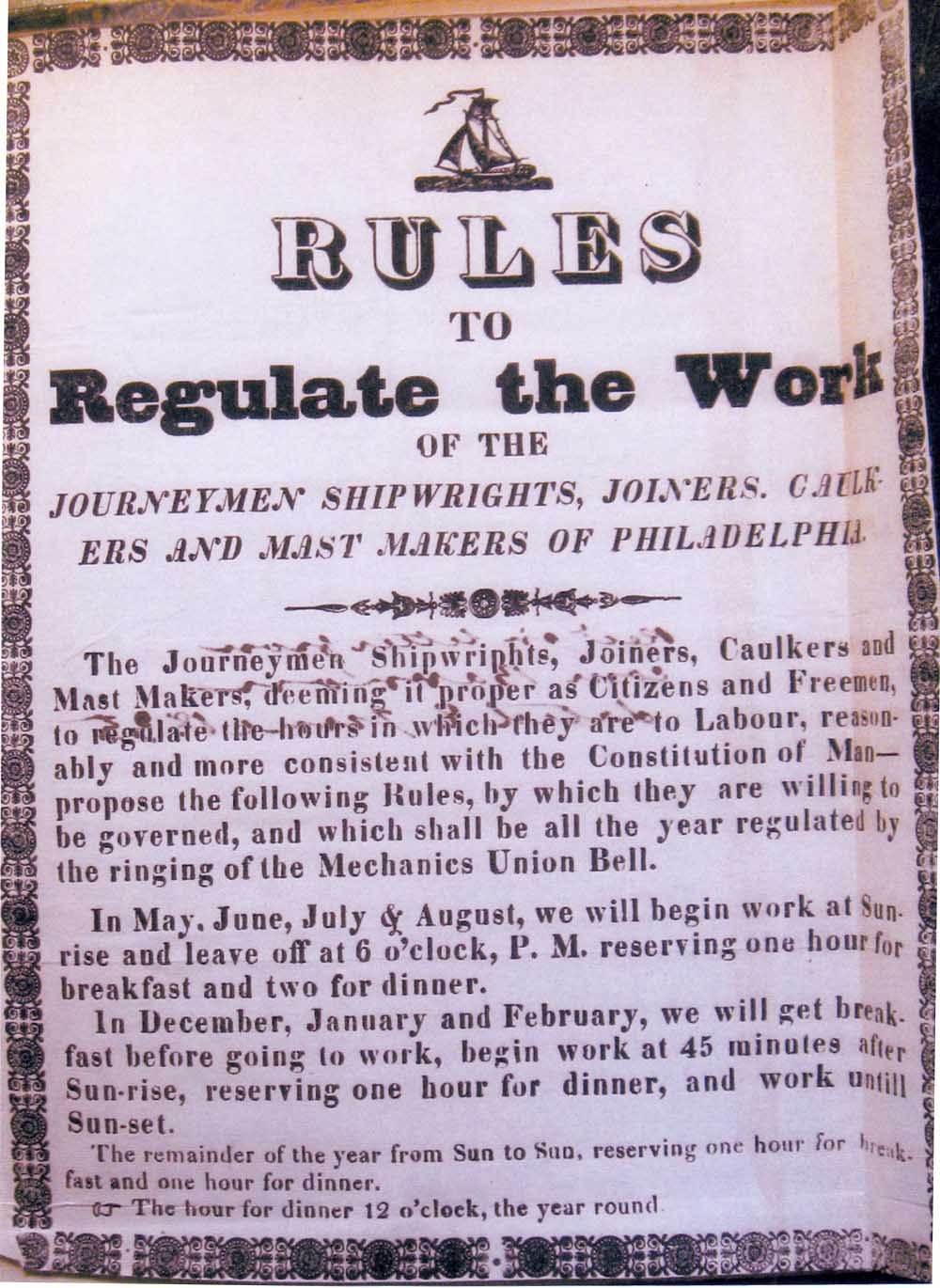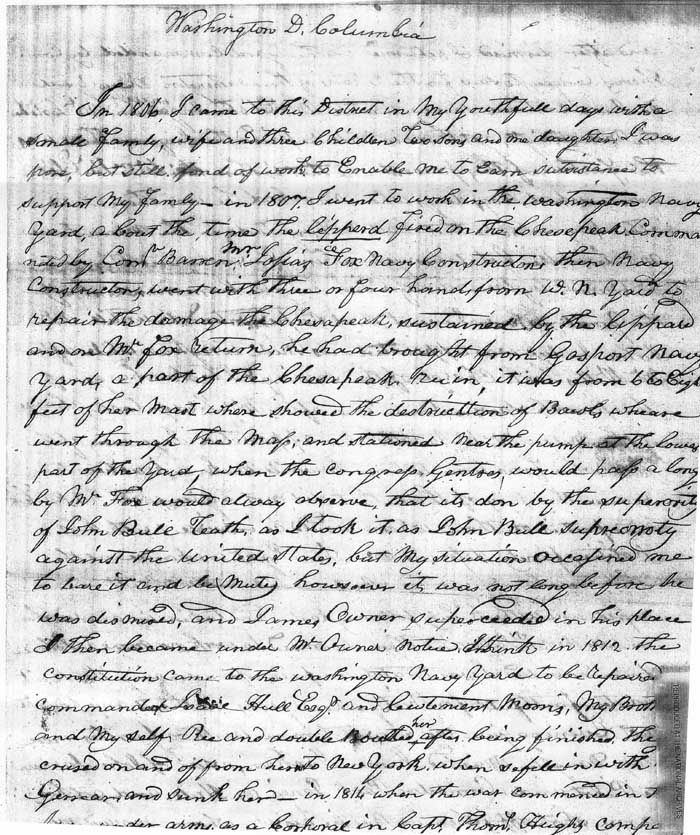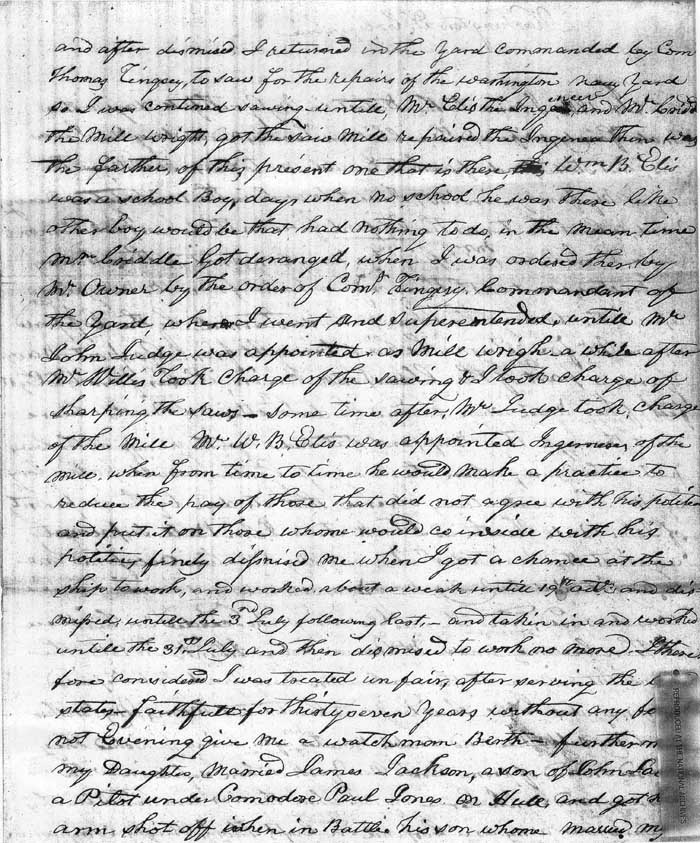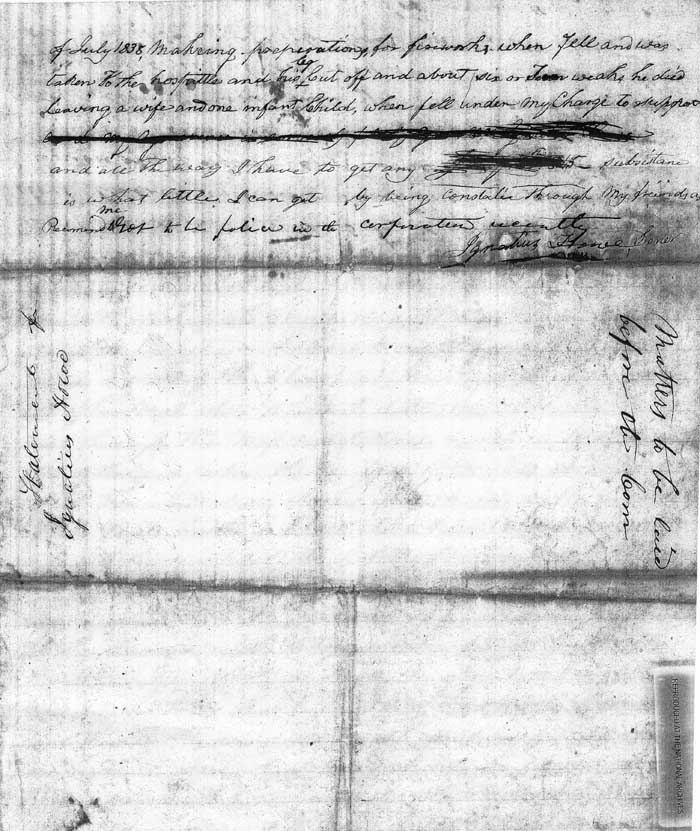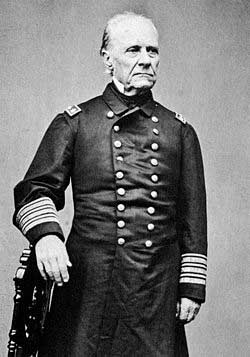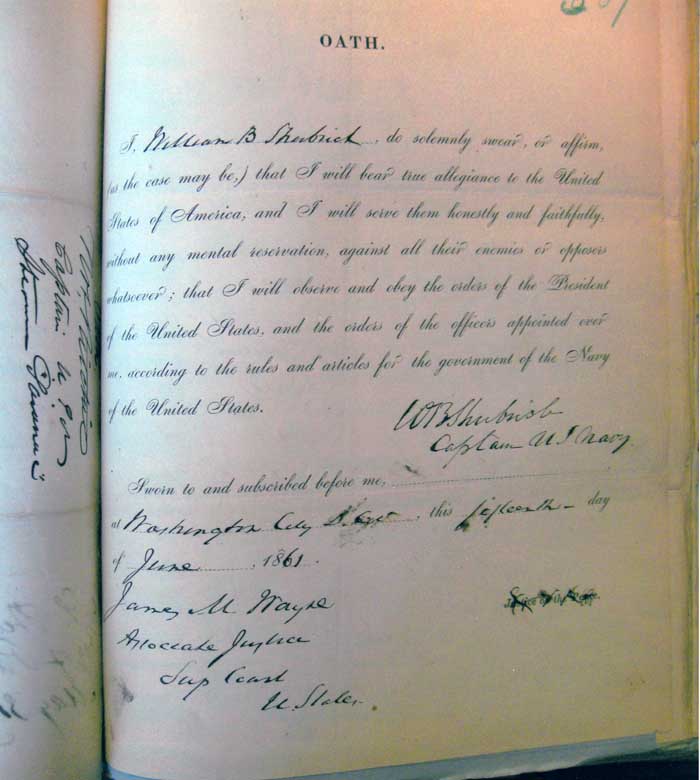Gosport Navy Yard: Controversies Regarding Hours of Work, Layoff, etc.
Daily National Intelligencer, Washington DC, 31 March 1843
North American, Philadelphia, 26 October 1843
Augusta Chronicle, Augusta, Georgia, 26 June 1851
Daily National Intelligencer, Washington DC, 3 July 1851
Baltimore Sun, Baltimore Md., 14 July 18511861 Oath of Allegiance & Obituary of Captain William B. Shubrick (1790-1874)
* * *
Introduction: In the 1830's shipyard workers at Gosport Navy Yard faced tough economic and employment challenges. In law and in fact they were day laborers, paid a per diem wage that is only for days actually worked. Life for mechanics and laborers everywhere in the new nation was precarious for the work hours were long and pay relatively low. Like elsewhere, the standard workweek at Gosport Navy Yard was twelve hours per days (referred to as "dark to dark" and six days per week. For the mechanics and laborers the only real certainties were often hard and unpleasant. A cold winter along the Elizabeth River usually was followed by mass layoffs as only the most essential crews would be kept working. Fewer naval ships to repair invariably meant fewer mechanics and laborers on the Yard payrolls. These conditions, and especially any cutbacks in annual naval appropriations, made the workforce particularly vulnerable to economic downturn, a wage reduction and or prolonged unemployment, rapidly led men to destitution. Most workers had little savings on which to fall back and imprisonment for debt continued as a reality experienced by thousands of workers each year.
Walkouts and strikes for higher wages or for the ten hour day almost everywhere in the new nation were successfully challenged in the courts. In the early nineteen century strikes were thought to constitute illegal conspiracies in common law and exposed striking workers to criminal prosecution. Indeed, many individual states banned labor associations as "injurious to public morality or trade or commerce." Despite these legal impediments, shipyard workers struck for higher wages and the ten hour day. While scholars generally consider the first strike by civilian employees in a federal shipyard to have occurred at the Washington Navy Yard in 1830, there is strong evidence that as early as 1827 the mechanics at the Pensacola Navy Yard successfully struck over their grievances regarding wages and hours. But most early strikes were not successful, for shipyard workers rarely had the financial resources necessary to survive a prolonged absence. One such unsuccessful strike took place on 19 June 1834 when Gosport Navy Yard carpenters struck for higher wages. While few details of this strike are known it is evident from surviving documents that the carpenters were in no position to bargain, some carpenters had remained at work, the strikers were unable to gain public support and that their strike rapidly collapsed.
After the collapse of their strike, the carpenters petitioned (see below) the Secretary of the Navy for some assurance that they could once again be entered on the shipyard rolls, which the Commandant Lewis Warrington somewhat reluctantly provided. It is unclear how many of the strikers actually returned to work. Their struggle for a better wages and a shorter workday however continued, with a goal of a ten hour day. A key aspect of this campaign concerned the way organizers framed their demand. They argued that the ten hour day was needed not only to protect the health of workers, but also because the long and exhausting workday was a barrier to education and full participation in American democracy. A circular issued in 1835 by Boston workers advocating the ten hour day, highlights the connection: "We have been too long subjected to the odious, cruel, unjust and tyrannical system which compels the operative mechanic to exhaust his physical and mental powers. We have rights and duties to perform as American citizens and members of society, which forbid us to dispose of more than ten hours for a day's work." The Philadelphia Navy Yard strike for ten hours was part of a large number of labor actions that took place in the summer of 183. Posters regarding this strike were sent to all the major shipyards. The ten hour campaign after many travails resulted in the first successful effort in the federal shipyard to reduce the workday, when in 1840 President Martin Van Buren by executive order reduced the shipyard workweek from twelve to ten hours per day six days a week. The new work week went into effect in Gosport Navy Yard shortly afterwards.
Transcription: This transcription was transcribed from digital images made at the National Archives Records Administration, Washington D.C. I have striven to adhere as closely as possible to the original in spelling, capitalization, punctuation and abbreviation (e.g. "…. , " , Do" or "do" for ditto or same as above) including the retention of dashes, ampersands and overstrikes. Where I was unable to discern word or sentence or where it was not possible to determine what was written, I have so noted in brackets. Where possible, I have attempted to arrange the transcribed material in a similar manner to that found in the letters and enclosures. John G. Sharp, Concord CA* * *
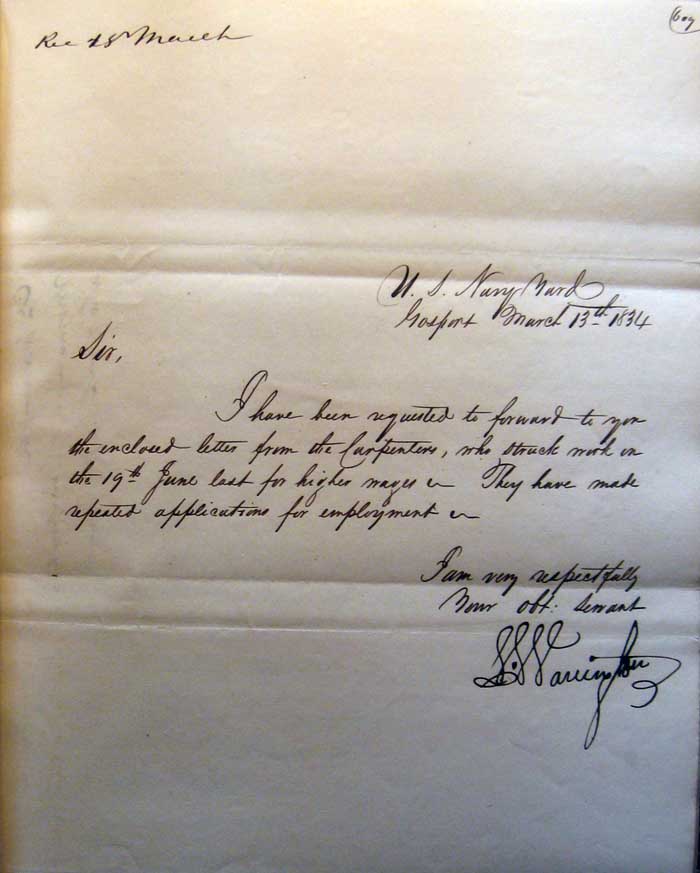
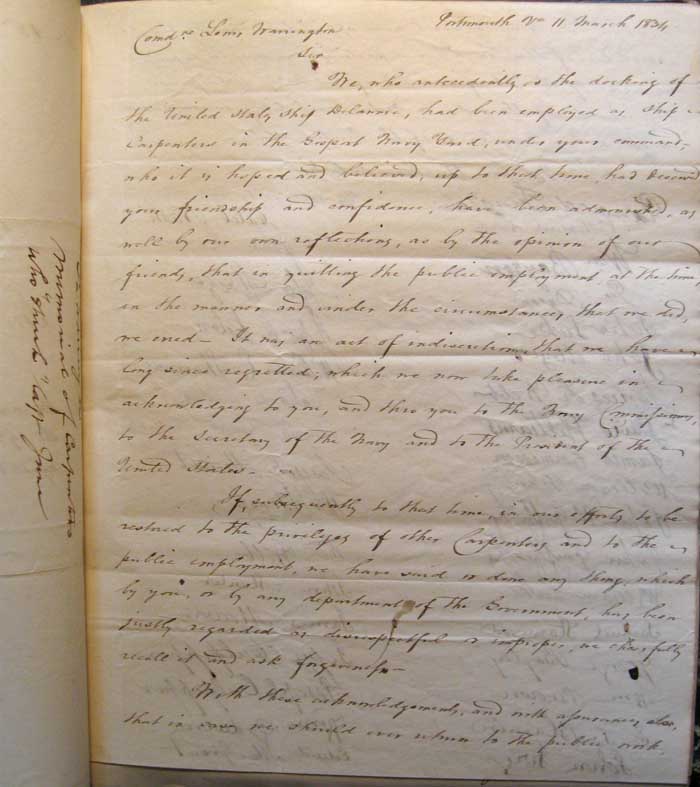
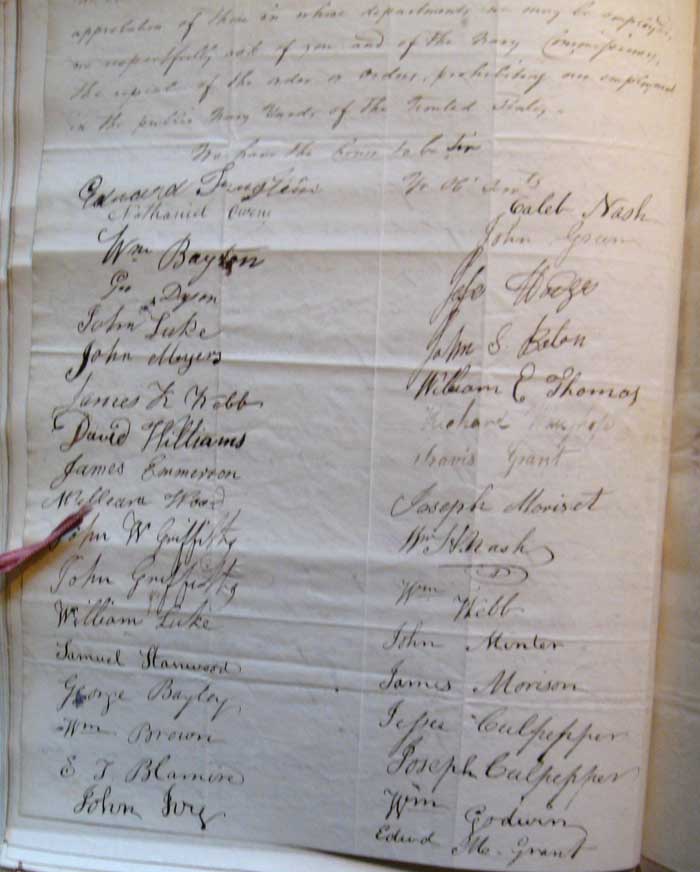
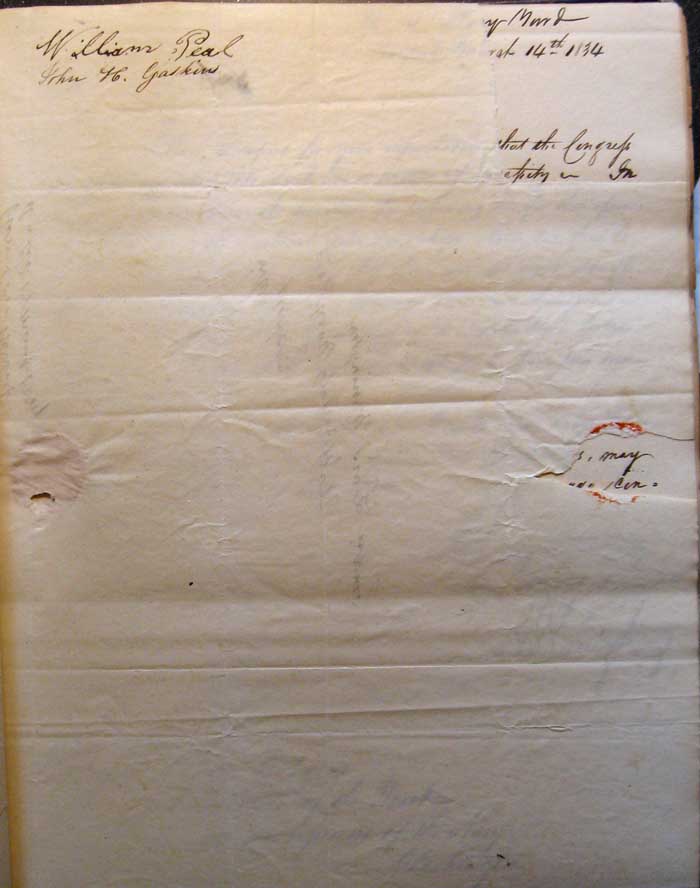
(Images will enlarge in browser)Portsmouth Va 11 March 1834
Commdt Lewis WarringtonSir
We, who antecedently in the Docking of the United States Ship Delaware, had been employed as Ship Carpenters in the Gosport Navy Yard, under your command, who it is hoped and believed, up to that time, had deserved your friendship and confidence, have been admonished, as well by our reflection, as well as by the opinion of our friends, that in quitting the public employment at the time, and the manner, under the circumstances, that we did, we erred - It was an act of indiscretion, that we have in long since regretted; which we now take pleasure in acknowledging to you and thru you to the Navy Commissioners, to the Secretary of the Navy and to President of the United States –
If subsequently to that time, in our efforts to be restored to the privileges of other Carpenters and to the public employment, we have said or done anything which by you, or any department of the Government, has been justly regarded as disrespectful or improper, we cheerfully recall it and ask forgiveness –
With those acknowledgement and with this assurance, also that in case we should ever return to the public work we shall endeavor to merit your approbation and the approbation of those whose department we may be employed, we respectfully ask of you and the Navy Commissioners the repeal of the order prohibiting our employment in the public Navy Yards of the United States –We have the honor to be Sir
Yr. Obedt Servt
[Signed]
Edward Fenglein Caleb Nash Nathaniel Owen John Green Wm. Bayton Jesse Hodge Geo. Dyson John S. Beton John Luke William E. Thomas John Myers Richard Wanshop James K. Webb Jarvis Grant David Williams Joseph Moriset James Emmerson Wm. H. Nash William Wood Wm. Webb John W. Griffiths John Minter John Griffiths James Morison William Luke Jesse Culpepper Samuel Stanwood Joseph Culpeper George Bayley Wm. Godwin Wm. Brown Edward M. Grant John Ivy William Peal John H. Gaskin
* * *
U.S. Navy Yard
Gosport March 13th 1834
Sir,I have been requested to forward to you the enclosed letter from the Carpenters, who struck on the 19th June last for higher wages – They have made application for employment –
I very respectfully
Your Obt Servant
[signed] L. W. Warrington
* * *
U.S. Navy Yard
Gosport, May 9 1834Sir,
Your two letters of the 3rd inst have been received. The Carpenters, who have made representations to you of their want of work, have not been in any manner, deceived or misled, except by their sanguine expectations of unceasing employment.
They were explicitly told by me, that as long as they had work, they should be retained; & that of course when that failed they would be discharged.They were placed on the roll immediately after them who remained; that they might part take with them, of the advantages or disadvantages, which might be offered.
The estimate for work at the Hospital, was forward (because called for) by a letter of the board.
I am respectfully
Your Obedient Servant[Signed] L. W. Warrington
Commd. John Rodgers
President of the Board of Commissioners of the Navy Washington
* * *
NOTES:
1. Sharp, John G., History of the Washington Navy Yard Civilian Workforce 1799-1962 (Stockton: Vindolanda Press, 2005), 23. Tingey to Robert Smith 16 May 1806 RG45/M125,NARA re proposed wage reductions averaging 17%. Tingey to Paul Hamilton, 7 and 29 January 1813, RG 45/M125, NARA.
2. Debt laws allowed imprisonment of individuals as guarantee that he or she would be available for trial. The District allowed creditors to secure a legal writ sufficient for the County Marshall to arrest and detain the debtor in the County Jail. For example even small debts like $1.68 could result in a debtor being incarcerated in Washington County Jail See Library of Congress, Papers of Thomas Jefferson Series I, General Correspondence, 1651-1827 A list of Debtors in the Washington Jail dated 29 March 1803
See: http://memory.loc.gov/cgi-bin/query/P?mtj:1:./temp/~ammem_J6y6
3. Dibble, Ernest F., Antebellum Pensacola and the Military Presence. Pensacola Series Commemorating the American Revolution Bicentennial 3, (Pensacola, FL: Pensacola/Escambia Development Commission) 1974, p. 13.
4. In 1840 President Martin Van Buren, by Executive Order, changed work hours in federal naval ship yards from 12 to 10 per day. The order as implemented at all federal naval yard statedBy Direction of the President of the United States all public establishments will hereafter be regulated as to working hours by the "ten hour System". The hours for labor in this Yard will therefore be as follows viz: From the 1st day of April to the 30th day of September inclusive from 6 o'clock a.m. to 6 o'clock p.m. -- during this period the workmen will breakfast before going to work for which purpose the bell will be rung and the first muster held at 7 o'clock -- at 12 o'clock noon the bell will be rung and then home from 12 to 1 o'clock p.m. allowed for dinner from which to 6 o'clock p.m. will constitute the last half of the day.
From the 1st day of October to the 31st day of March the working hours will be from the rising to the setting of the Sun -- the Bell will then be rung at one hour after Sunrise that hour being allowed for breakfast -- at 12 o'clock noon the bell will again be rung and one hour allowed for dinner from which time say 1 o'clock till sundown will constitute the last half of the day. No quarters of days will be allowed.
* * *
1835 Philadelphia Navy Yard poster which was widely distributed to all the major shipyards in the summer of 1835 in support of the ten hour day.
(Image will enlarge in browser)* * *
Petition of Ignatius Howe to the Secretary of the Navy circa 1845
Introduction: Autobiographical accounts from early nineteenth shipyard mechanics and laborers are rare. The petition of Ignatius Howe to the Secretary of the Navy circa 1845 is a fortunate exception. Howe's plea for reinstatement to his former position on the Washington Navy Yard was written solely to reclaim his job yet it provides considerable information regarding Howe's life, his family and their financial circumstances. Ignatius Howe was born in Prince Georges County Maryland circa 1778, in 1798 Howe married Rachel Willett, and the young couple moved in to the District of Columbia in 1806. Howe went to work the next year at the Washington Navy Yard as a laborer. During the war of 1812 Howe tells us he served briefly in a militia company, after his service he resumed work at the navy yard as sawyer and laborer. In August 1814, the navy yard was burned to prevent capture by British forces. Howe and most of the workforce were laid off for over a year until Congress authorized funds for rebuilding. Howe was able to resume work about 1815; he continued to work as laborer and occasionally as sawyer until he was laid off in July 1844. Howe relates Navy first laid him off on 19 October 1843. While Howe alleges his discharge was political retribution conceived by master mechanic John Judge, his termination was more likely prompted by the Navy Department's massive budget shortfall. This shortfall resulted from the failure of the 1843/1844 congressional appropriation for the navy, a failure which resulted in the discharge of hundreds navy yard employees. Howe was apparently unable to reclaim his job but with the assistance of friends found employment as a police constable. Ignatius Howe worked as a constable for a few years, but as enumerated on the 1850 census for the District of Columbia, he is listed as age 72, unemployed, living with his son Richard Howe, a blacksmith, Richard's wife Elizabeth and the couple's three children Sarah, Mary and Catherine. The date of Ignatius Howe's death is unknown.
Source: National Archives and Records Administration, Washington DC, Record Group 45.
Transcription: I have striven to adhere as closely as possible to the original in spelling, capitalization, punctuation and abbreviation including the retention of dashes, ampersands and overstrikes. Where I was unable to print a clear image or where it was not possible to determine what was written, I have so noted in brackets. Where possible, I have attempted to arrange the transcribed material in a similar manner to that found in the letters and enclosures. All transcriptions of documents quoted are mine. John G. Sharp Concord, California 6 September 2011* * *
In 1806, I came to the District in my youthful days with a small family, wife and three Children Two sons and one daughter I was poor, but still fond of work to Enable me to earn sustenance to support my family - in 1807 I went to work in the Washington Navy Yard, about the time the Leppard [HMS Leopard ]Fired on the Chesapeake Commanded by Com. Barron. Mr. Josiah Fox Navy Constructor then Navy Constructor, went with three or four hands from W. N. Yard to repair the damage the Chesapeake, sustained by the Lepperd [Leopard] and on Mr. Fox return, he had brought from Gosport Navy Yard, a part of the Chesapeake ruin, it was from 6 to Eight feet of her Mast where showed the destruction of bowls [balls] where went through the Mass; and stationed near the pump at the lower part of the yard, when the congress, Gentes , would pass a long by Mr. Fox would always observe that its don by the superiority of John Bull Teath [Teeth?] I took it, as John Bull Superiority against the United States, but my Situation occasioned me to bare it and be Mute however it was not long before he was dismissed, and James Owner superseded in his place I then became under Mr. Owner notice I think in 1812. the constitution [USS Constitution] came to the Washington Navy Yard to be repaired Commanded by Isaac Hull Esq. and Lieutenant Morris, My Brother and my self, rec and double bowled her + after being finished they cruise on and of from her to New York, when se [she] fell in with Gerrear [HMS Guerriere], and sunk her
In 1814 when the war was commenced in [illegible] I was under arms as a Corporal in Capt. Thom. Hughes company and after dismissed I returned in yard Commanded by Thomas Tingey to saw for repairs of the Washington Navy Yard so I continued sawing - until Mr. Elis [Samuel Ellis] the Ingeneur [Engineer] and Mr. Criddle the Mill wright got their saw mill repaired the Ingenenur was then farthest of this present One that is there, Wm. B. Elis [Ellis] was a school Boy days when no school he was these like other boys would be that had Nothing to do, in the mean time Mr. Criddle Got deranged, when I was ordered there by Mr. Owner by the order of Com. Tingey, Commandant of the Yard, where I went and superintended, until Mr. John Judge was appointed as Mill Wright a while after Mr. Willes Took Charge of the sawing & I took charge of sharping the saws – Some time after, Mr. Judge took charge of the mill, when from time to time he would make a practice to reduce the pay of those that did not agree with his politics and put it on those who would co inside with his politics finely dismissed m when I got a chance at the ship to work and worked about a week until 19th Oct and dismissed until the 31 July and then dismissed to work no more
I therefore considered I was treated un fair , after thirty seven years without and faults no even giving me a watchman's Berth Further My Daughter married James Jackson, a son of John Jackson a Pilot under Commodore Paul Jones or Hull and got a arm shot off when in Battle his son whom married my daughter [and] of July 1838 making preparations for fireworks when [he] Fell and was taken to the hospital and his leg Cut off and about six or ten weeks he died leaving a wife and one infant Child where fell under my Charge to support [one line crossed out] and all way I have to get any [two words crossed out followed by what appears to be 1845] subsistence is all that I can do by being a constable through my friends as recommend me Got to be police in corporation recently
[Signed] Ignatius Howe
Statement of Ignatius Howe
Matter to be laid before the Com.End Notes:
1. The New England historical and genealogical register, Volumes 72-73 January 1918 By New England Historic Genealogical Society p. 224.
2. Josiah Fox 1763 -1847 born in England, well known ship constructor or naval architect noted for his involvement in the design and construction of the first significant warships of the United States Navy. Fox was born into a Quaker family (Society of Friends) and completed his apprenticeship at the Royal Dockyard Plymouth. He later served as a shipwright. In 1793 he traveled to the United States where in 1794, despite his religious affiliation's avowed pacifism he was employed by the United States Navy as a draftsman working under Naval Constructor Joshua Humphreys, the designer of the first Navy frigates, with Humphreys he helped designed the USS Constitution. In contrast to many Quakers, Josiah Fox, owned slaves see Paul Hamilton 11 August 1809 letter to Thomas Tingey regarding William Fox carpenter apprentice whom Josiah Fox later freed.). Josiah Fox's tenure at Washington Navy Yard 1804 -1809 was terminated see Paul Hamilton's to Josiah Fox 2 August 1809 NARA RG 45 M125 regarding his disputes with Commodore Thomas Tingey. Fox later moved to Ohio where he lived until his death in 1847.
3. 1850 U.S. Census for the District of Columbia , Washington City , Ward 6, Microfilm Roll 432 – page 76A, Image:158,
4. The Chesapeake-Leopard affair, also referred to as the Chesapeake Affair, occurred on June 22, 1807, when the British warship HMS Leopard attacked and boarded the American frigate Chesapeake. The attack was prompted by the British claim to an unrestricted right to board foreign vessels and reclaim their nationals and forcibly recruit or impress seamen. These naval actions increased the tension between the two nations and led to the occasional threats of war.
5. John Bull a popular caricature widely used in the nineteen century press to represent Great Britain, similar to Uncle Sam for the United States.
6. James Owner, Master Ship Builder at the Washington Navy Yard.
7. On 19 August 1812 the USS Constitution engaged the HMS Guerriere. A quarter-hour of intense gunnery by Constitution, delivered with much superior accuracy, battered Guerriere in the hull and masts. The British frigate's mizzenmast fell over the side, crippling her ability to maneuver. Constitution then moved ahead to rake Guerriere, whose bowsprit caught in the American's mizzen rigging. Firing continued while the two ships were thus tangled, and both sides prepared boarding parties. Marksmen in the mast tops blazed away at exposed personnel, with deadly effect. Many officers and men were thus killed, including Constitution's Marine lieutenant. Others, Captain Dacres among them, were wounded. As the ships separated, Guerriere's foremast collapsed, pulling down the mainmast with it. She was now a "defenseless hulk", and surrendered at 7 PM, when Constitution approached to renew the action after making brief repairs to her modest damages. British casualties were more than five times those of the Americans, and Guerriere was beyond saving. Her surviving crewmen were taken off the next day, she was set afire and soon blew up. Constitition then returned to Boston with her prisoners, arriving on 30 August.
8. Samuel B. Ellis, Steam Engine Operator, Washington Navy Yard see http://www.history.navy.mil/library/online/wny_payroll1819-1820.htm
9. Jonathan Criddle, master millwright, Criddle experienced severe financial problems that resulted in his bankruptcy and being forcibly placed in the District of Columbia Poor House, see: http://genealogytrails.com/washdc/lawprisons/poorhouser.html. Criddle, had history of problems with debt, he had worked at Washington Navy Yard, where he was employed to help erect the navy yard engine and afterward stayed on as pattern maker and millwright. On 26 April 1823, after suffering severe economic losses, Criddle, wrote to WNY Commandant, Commodore, Thomas Tingey, pleading for his assistance. Criddle begged that he had been unjustly taken from his home by force and trickery to the District poor house and there he received "such treatment as I meet with … savages could not be guilty of administrations more cruel." Source: Latrobe to James Smallman, October 5, 1810, Benjamin H. Latrobe Papers of Benjamin Henry Latrobe.. (Maryland Historical Society, New Haven: Yale University Press, 1984-1988) Volume II P. 908 and Criddle to Tingey 26 April 1823, NARA, RG 45, E 314. Criddle was detained on 5 December 1842 by the District Metropolitan Police "for wandering about" see Baltimore Sun for 13 December 1842, but released the following morning. Criddle died on 15 June 1846 and is buried at Congressional Cemetery R 36 /3.
10. Ignatius Howe is enumerated on the 1819 /1829 pay roll of Washington Navy Yard employees as a sawyer top and paid $ 1.34 per diem http://www.history.navy.mil/library/online/wny_payroll1819-1820.htm.
Sawyers cut logs prior to the adoption mechanize saw mills. the work was performed using a saw pit where one man worked on top and the other on the bottom.
11. Disable soldiers and sailors were often given appointments at WNY as watchmen.
12. Sylvester, Richard, District of Columbia Police a retrospective of the police organizations, Gibson Brothers: Washington DC, p. 30 for Howe’s 1836 appointment as a police constable for ward 6. While it’s unclear how long Howe worked as a constable, his name is mentioned as in 1845. See National Intelligencer 29 April 1845, in which Howe served a writ for the Justice of the Peace against the goods and chattel, land and tenants of Levi Branch and William Austin and the last mention in 1850 is when his nomination for 6th ward constable is withdrawn see National Intelligencer 9 July 1850.* * *
Gosport Navy Yard: Controversies Regarding Hours of Work, Layoff, etc.Introduction: The two decades following President Martin Van Buren’s 1840 executive order mandating a ten hour work day at all federal shipyard were followed by periodic controversy as to its validity and implementation. Some of these difficulties were the result of local interpretation by commanding officers while others were the result of issuances from the Navy Department itself. An example of the latter is the 1843 dispute by Gosport mechanics and laborers with Secretary of the Navy Abel P. Upshur regarding hours of work. Secretary Upshur wanted to increase shipyard productivity by lengthening the workday while reducing cost. This serious disagreement was finally resolved amicably, after the mechanics sent a friendly emissary a Dr. William Collins, to speak for them directly with President Tyler. As late as 1852, then Secretary of the Navy John P. Kennedy, arbitrarily attempted to set aside President Van Buren's 1840 ten hour workday order, and in order to increase production at Charlestown and Washington Navy Yard issued his own order to begin the workday at both yards an hour earlier, or from sunrise to sunset. This effectively extended the workday to eleven hours. At the Charlestown Navy Yard, Secretary Kennedy's order resulted in a strike of three hundred mechanics and laborers. At the Washington Navy Yard, employees also began work stoppages. Secretary Kennedy's order was quickly rescinded just forty-eight hours after it was issued and both yards returned to work.
Another source of strife, a perennial one, was how to prevent the theft of government property. In 1851 Gosport Navy Yard Commandant Silas Stingham, became aware of the theft of copper and other items of value from the yard. To prevent further larceny, Stringham imposed drastic restrictions on the number of entrances and times of access to the navy yard. One of his most controversial actions effectively blocked mechanics and laborers from entering their workplace until the precise time the morning work bell rang. Stringham‘s order although well intended had the unintended consequence of lengthening the workday and questioning the integrity of his workforce. The Gosport mechanics send a delegation to the White House and were able to secure the support of the Secretary of the Navy to rescind the order.
The articles transcribed below are all from the newspapers of the era and the language, and spelling is that of the original.
John G. Sharp
Concord, California 11 September 2011* * *
Daily National Intelligencer
Washington DC
31 March 1843Gosport Navy Yard
At a meeting of the mechanics and working men (employed in the U.S. Navy Yard, Gosport) held at the Town Hal, Portsmouth, Va., on Monday evening, March 27th 1843, Mr. Thomas Green was called to the chair, and Mr. John L. Porter appointed secretary.The chairman having stated, that the meeting had been called to hear the report of Dr. William Collins, who had been sent as a delegate to intercede for us respecting the working hours in the yard with President Tyler at Washington, and the Hon. Secretary of the Navy , A. P. Upshur. Dr. Collins arose and stated to the meeting that he had carried out their wishes to the best of his ability; related the conversation he had with President Tyler during an interview – also read a letter from the President and one from the Secretary of the Navy, all of which were highly gratifying to the meeting.
On the motion of Mr. John A. Foreman, it was received that a committee of three be appointed to prepare a preamble and resolutions suitable to this occasion, whereupon, Messrs. John A. Freeman, Robt. Scott, and Wm. Gleason, were appointed by the chair to compose said committee.
The Committee having retired for a short time returned and reported the following preamble and resolutions.
WHEREAS: The mechanics and laborers in the employment of the Government at this Navy Yard, have felt desirous that a system of working hours commonly called the Ten hour system, now in operation should be continued; and as an expression of their wish has been formally made by their representatives and delegate, Dr. William. Collins, in person, to his Excellency John Tyler, the President of the United States, and as his reply, through the afore said sources has been received by this meeting; and by consultation with our feeling and wishes, which was to have been expected from the high and honorable source, which we addressed, and as we further learned the Honorable A.P. Upshur, the Secretary of the Navy, fully accords with the Executive in the sentiment therefore be it:
Resolved, That his Excellency, John Tyler, has displayed in this matter a judgment which is sound and feelings of sensibility and deference for the rights, riches and feelings of the mechanics and laborers which do infinite honor to his head and reflects the highest eulogy on his heart.
Resolved, That we tender to him our cordial and unfeigned thanks for the kindness and courtesy displayed both our delegate and the subject submitted for his consideration.
Resolved, That our thanks are due and are hereby respectfully tendered to the Honorable A.P. Upshur, Secretary of the Navy, which for his contemplated action in relation to this subject, which we believe is predicated upon an honest desire to promote the mechanics and laborers as far as is consistent with good faith and his obligation to the Government.
Resolved, That the cordial acknowledgements to this meeting are hereby made to Dr. William Collins, for the kind promptitude with which he acceded to our request to visit the seat of Government that the remembrances of this grateful service will always be held in lasting recollections.
Resolved, That a copy of these proceeding signed by the chairman and secretary be transmitted to the editor of the Madisonian, with a request that he will publish the same; and that the editors of the Norfolk and Portsmouth papers be also requested to insert the same in their respective journals.
On the motion it was Resolved that the above preamble and resolutions be adopted
{Signed} THOMAS GREEN, ChairmanJno. L. Porter, Secretary
* * *
Introduction: In October 1843, a mass layoff at Gosport Navy Yard workers placed many long service employees and their families in dire straits. This mass layoff was prompted by delay in passage of the annual congressional appropriation for the naval service. As a consequence workers at all federal shipyards were laid off and many were unable to resume employment until the spring of 1844.This 1843 lay off was disaster, for in the 19th century there was no unemployment insurance, most workers lived pay day to pay day and few if any private charities could meet this level of need. While Norfolk mechanics and laborers always faced a precarious economic and employment status, this mass lay off was the worst in terms of numbers and duration. Those who worked at the Gosport often found the shipyard seasonal work fluctuations mean lay off particularly in the long cold winter months but the layoff of 1843 was far longer and effects more widely felt, for many of the employees received no wages for six months. What this incident starkly reveals is that shipyard workers were in law and in fact day laborers, and paid a per diem wage but only for days actually worked. Theirs was a life where the only real certainties were often hard and unpleasant. A cold winter usually led to mass reductions in force as only the most essential crews would be kept working. Fewer naval ships to repair invariably meant fewer mechanics and laborers on the Yard payrolls. These conditions, and especially any cutbacks in annual naval appropriations, made the workforce particularly vulnerable to economic downturn, a wage reduction and or prolonged unemployment, which rapidly led the men to destitution.
John Sharp
Concord , Ca 12 September 2011* * *
North American
Philadelphia
26 October 1843DISCHARGE of WORKMEN FROM THE GOSPORT NAVY YARD – We learn that orders were received on Saturday from Washington , by the commandant of the Navy Yard at this station, to discharge all mechanics and laborers, except so many as are required to complete the new sloop of war for launching, and for some other small unfinished business. Four hundred at least, it is said, will be thrown out of employment by virtue of these orders; and at the eve of a long winter, without any resource but their daily labor, a wretched and hopeless prospect lies before them, which cannot be contemplated without giving pain to every heart capable of feeling for other’s woe. And why is it so? Plainly because the appropriations have been improvidently and imprudently applied, until what was drawn for twelve months has been exhausted in eight. Misgovernment and mal –administration are causes in this deplorable state of things – Norfolk Herald
* * *
Augusta Chronicle,
Augusta, Georgia
26 June 1851Norfolk, June 23 – This morning, when the mechanics and laborers employed in the Gosport Navy Yard, arrived at the gate they found it closed, and were informed that it had been done by the order of the Commandant, and that hereafter they were to remain outside till the bell rang. Deeming this an infringement on their rights, and a movement uncalled for, the workmen immediately determined not to submit to it, at the tap of the bell gave three cheers and returned in a body to Portsmouth where they repaired to the City Hall and proceeded organize a meeting. A committee was then appointed to wait on Capt. Stringham and learn why the order was issued. The Commandant in reply stated that some of the operatives in the Yard had been detected in pilfering, and he had adopted this plan to prevent their coming in, except during business hours. He also refused to revoke the order and ordered the names of all workmen who were not present when the bell rang at 12 o’clock to be stricken from the roll. The meeting upon learning this, appointed another Committee to proceed to Old Point and request the interference of the President. They immediately chartered a steamboat and proceeded on their mission. After several speeches were made in which the Commandant and Captain were handled without gloves, they resolved not to return to work until this order was revoked , and then adjourned to await the report of the Committee. The greatest excitement prevails in Portsmouth.
* * *
Daily National Intelligencer
Washington DC
3 July 1851Gosport Navy Yard
Speaking of the satisfactory settlement of the late difficulties at the Gosport Navy Yard, the Norfolk Beacon says: From all that we can learn the whole difficulty has arisen from a misunderstanding of the reasons for keeping the gates closed until the bell rung, which might have been as easily settled in a few minutes after
"From all that we can learn the whole difficulties has arisen from a misunderstanding of the reasons for keeping the gates closed until the bell rung, which might have been as easily settled in few minutes after the bell had ceased ringing on the morning the bell had ceased ringing on the morning the obnoxious order was issued as by sending a Committee to Washington, and at the infinitely less cost. The well-known character of the officers of the yard warrants us in the expression is over, the majority of the workmen will agree with us. Be this as it may, the affair is deeply regretted.
* * *
Baltimore Sun
Baltimore Md.
14 July 1851THE GOSPORT NAVY YARD TROUBLES
The Norfolk papers publish the following letter from Mr. GRAHAM, the Secretary of the Navy, in relation to the recently - discovered depredations upon the public property at the Gosport Navy Yard:
NAVY DEPARTMENT, Washington, July 8, 1851
SIR: I am gratified to acknowledge the receipt of a copy of the preamble and resolutions of a Public Meeting, over which you presided of the mechanics and laborers of the Gosport Navy Yard, pertaining to recent discoveries of public properties which has been abstracted from the yard, and found in the possession of persons of the vicinity, which copy was forwarded by Captain Stringham in compliance with the request of the meeting. And I cannot, but express my admiration of the high tone of morality and sensibility of character which pervades the proceedings of the members of your meeting, nor can I doubt that they will render the Government every assistance in their power in discovering the perpetrators of this offense.
All communities are liable to be disturbed by the crimes of individuals, but so just imputation can attach to a man of honest fame simply from the commission a crime in his neighborhood. Not only is the legal presumption against it, but all charities and better feelings of human nature.
I am, very respectfully, your obedient servant.
WILLIAM A. GRAHAMMr. JESSE CULPEPPER, Chairman &c., Norfolk, Va.
In our previous notice of the meeting we should have stated that Mr. Spaulding, in whose possession a part of the copper was found, asserts that it was purchased from Mr. Jesse Wilburn.
NOTES:
1. Washington Navy Yard , also experienced similar thefts but in the 1830’s in response Captain Isaac Hull denied workmen access to the yard until the bell and restricted the type of lunch packages they could bring on base. In response the mechanics and laborers went on strike in 1835, Captain Hull later modified his order. See the Diary of Michael Shiner p. 35, http://www.history.navy.mil/library/online/shinerdiary.html#page65.
2. Silas H. Stringham, Commandant Gosport Navy Yard, February 1851 - April 1852.
* * *
1861 Oath of Allegiance of Captain William B. Shubrick, Veteran of the War of 1812 and former Commandant Gosport Navy Yard
At the beginning of the Civil War all officers of the United States, were required to sign the oath of allegiance. On 15 June 1861, Captain William Branford Shubrick (1790 -1874), a native of South Carolina, chose to remain loyal to the federal government and to the navy which he had served for over half a century, with distinction, when he signed the oath of allegiance.
Shubrick began his long naval service in the age of sail and lived to see the dominance of steam powered vessels and the clash of iron ships. Shubrick entered the navy as midshipman in 1806, and on 22 June 1813 while assigned to the USS Constellation, he served heroically in the defense of Norfolk, where he led a party of bluejackets in beating off a British boat attack against Craney Island. Shubrick subsequently won a Congressional medal for service in Constitution during her capture of HMS Cyane and Levant. In 1840 Captain Shubrick was made Commandant Gosport Navy Yard, where he served from 7 October 1840 – October 1843. He later served with merit in the War with Mexico. In December 1861, Shubrick , by then over seventy years of age, was retired; and he promoted to Rear Admiral on the retired list on 16 July 1862. He died in Washington, D.C., on 27 May 1874. A transcription of William B. Shubrick’s signed oath is below.
OathI, William B. Shubrick, do solemnly swear, or affirm, (as the case may be,) that I will bear true faith allegiance to the United States of America, and I will serve them honestly and faithfully without any mental reservation against all their enemies or opposers whatsoever; that I will observe and obey the orders of the President of the United States, and the orders of the officers appointed over me, according to the rules and articles for the government of the Navy of the United States.
[Signed ] WB Shubrick
Captain US NavySworn to and subscribed before me, at Washington City D. C. , this fifteenth day of June, 1861.
James M. Wayne [Signed]
Associate Justice
Sup Court Justice of the Peace
U. StatesNotes
1. Dudley, Donald S., Going South: U.S. Navy Officer Resignations & Dismissal on the Eve of the Civil War. Washington: Naval Historical Foundation, see http://www.history.navy.mil/library/online/going_south.htmn , table III in 1861 of the 1554 serving United States Navy Officers 40% chose to resigned or were dismissed.
2. Dudley, William S. The Naval War of 1812, Volume II. Washington, DC: Naval Historical Center, 1992, p.359.
3. National Archives and Records Administration, Records Group 45, Department of the Navy, Affidavits of Loyalty 1862 -1865.
4. James Moore Wayne, 1790 -1867, Associate Justice United States Supreme Court.OBITUARY
New York Times,
28 May 1874
REAR ADMIRAL SHUBRICKRear Admiral William Branford Shubrick, the senior officer of the retired list, died in Washington, yesterday, in the 84th year of his age. He was the son of an officer of the Revolutionary Army, born in South Carolina, Oct. 31 1790, and entered the navy as a midshipman on the 28th of June 1806. He was commissioned Lieutenant on Jan. 5, 1813, and in that year, he commanded one of the gun – boats in an attack on a British frigate in Hampton Roads, in which the English vessel was disabled. In the same year, he commanded one of the guns on Craney Island near Norfolk, when the British made a land and water attack on the defenses, but was repulsed with loss. He participated as Third Lieutenant of the frigate Constitution in action which resulted in the capture of the sloops Cyane and Levant, and subsequently senior Lieutenant of the same frigate when she escaped from a British squadron off the Cape de Verde Islands. In the war of 1812, he won considerable distinction, and for his services in that war his native state presented him with a splendid sword and the thanks of the Legislature. On 29th of March 1828 he was commissioned Master Commandant. During the year 1827 he commanded the Sloop Lexington on a cruise to the coast of Labrador, and in 1830 he was Commander of the Navy yard at Washington. On the 21st of February he was commissioned Captain, and in 1839 , he was appointed to the command of the West Indies Squadron and in 1840 to the Norfolk Navy Yard . During 1845 -46, he was Chief of the Bureau of Provisions and Clothing. He commanded the Pacific Squadron during the Mexican War, in which he gained great renown, capturing the fortified town of Mazatlan from a superior force. In 1853 he commanded the Princeton and a small squadron on the eastern coast settling the fishing troubles with the British . In 1853 he was Chief of Bureau of Construction, and acted as Chairman of Light- house Board from 1854 to 1858. In 1859 he commanded the Brazilian Squadron and Paraguay expedition, and the result was highly commended by the President in his message to Congress. The President of the Argentine Confederation also testified his appreciation of Commander Shubricks success in that expedition by presenting him with a fine sword, which, by permission of Congress, was accepted by the Commander. At the outbreak of the rebellion in 1861 great efforts were made to induce him to espouse the Southern cause, but he remained faithful to the Union and strongly disapproved of succession. On the 16th of July 1862 he was commissioned as Rear Admiral. His total sea service was eighteen years and five months and "shore and other duty" thirty – eight years and five months. The rear Admiral was one of six brothers who served the country during the war of 1812.
Notes
1. 28 June 1806 is the date given by the Naval History and Heritage Command see http://www.history.navy.mil/books/callahan/reg-usn-s.htm* * *
John G. Sharp resides in Concord, California. He worked for the United States Navy for thirty years as a civilian personnel officer. Among his many assignments were positions in Berlin, Germany, where in 1989 he was in East Berlin, the day the infamous wall was opened. He later served as Human Resources Officer, South West Asia (Bahrain). He returned to the United States in 2001 and was on duty at the Naval District of Washington on 9/11. He has a lifelong interest in history and has written extensively on the Washington Navy Yard, labor history and the history of African Americans. His previous works include, History of the Washington Navy Yard Civilian Workforce 1799 -1962 http://www.history.navy.mil/books/sharp/WNY_History.pdf and the first complete transcription of the Diary of Michael Shiner Relating to the History of the Washington Navy Yard 1813-1869, on line: http://www.history.navy.mil/library/online/shinerdiary.html. Both works were published by the Naval History & Heritage Command. He recently completed African Americans in Slavery and Freedom on the Washington Navy Yard 1799 -1865, Morgan Hannah Press 2011. John served on active duty in the United States Navy, including Viet Nam service. He received his BA and MA History, from San Francisco State University. He can be reached at sharpjg@yahoo.com.
Norfolk Navy Yard Table of Contents
Birth of the Gosport Yard & into the 19th Century
Battle of the Hampton Roads Ironclads
